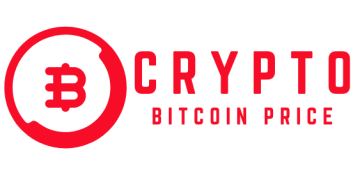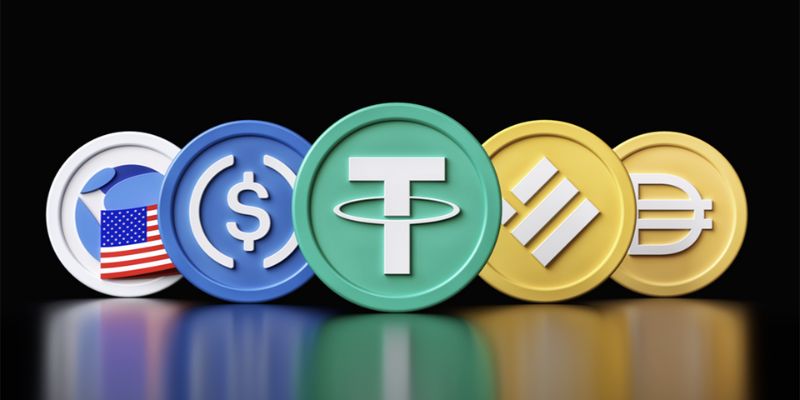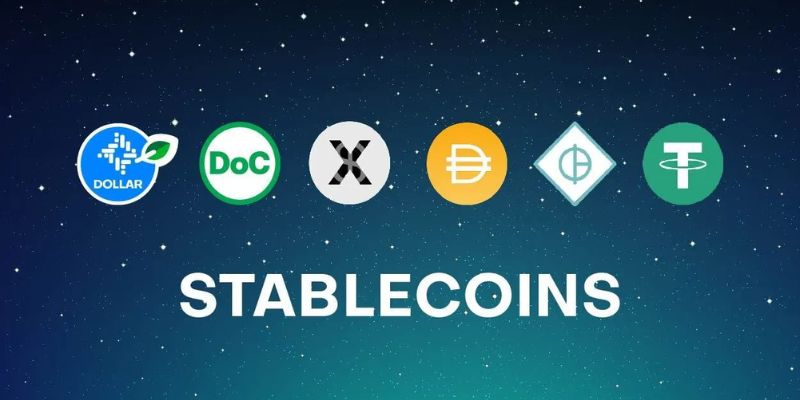Ever wonder what is a stablecoin? Let’s cut to the chase. Imagine digital money that dodges wild swings in value. That’s it. Real simple. They bridge the gap between crypto speed and real-world money value. In this guide, you’ll get the lowdown on how stablecoins stand firm when other cryptos dance to a wild rhythm. We’ll dig into what they’re made of and why they might be the cash of the future. Stay tuned for a no-fluff journey into the heart of stablecoin country.
Understanding the Basics of Stablecoins
Exploring the Stablecoin Definition and Purpose
What is a stablecoin? It’s a digital currency tied to a stable asset. Most times, this asset is money like the US dollar. This link helps it stay at a steady value. It’s not like other cryptos that go up and down a lot. Stablecoins aim to mix the stable value of money with the tech smarts of crypto. This makes them useful for buying things and sending money across the world cheap.
Classifying Different Types of Stablecoins
There are a few kinds of stablecoins. Each works in its own way.
First, there’s the fiat-collateralized stablecoin. These are real simple. They are like a promise that you can trade a stablecoin for real money any time. This means for each stablecoin out there, there’s real money kept safe by the people who made it. A couple of big names are Tether (USDT) and USD Coin (USDC).
Next up, we have crypto-backed stablecoins. These are backed by other cryptos instead of money. It’s a bit tricky since the cryptos backing them can change in value. To keep the stablecoin stable, they use smart tech to handle how much is out there.
Then we have algorithmic stablecoins. Think of these like a see-saw. They balance their value not by having money or other cryptos in a vault, but by computer rules that manage their supply. If the value goes up, the rule makes more coins. If it goes down, it makes less.
Stablecoins are growing fast. Folks are using them more because they like how they work. When you use stablecoins, you often pay less in fees than with regular money transfers. This makes them really good for business and sending money around.
Each of these stablecoins follows rules, or regulations, to stay safe and fair. These rules are super important because they help people trust stablecoins. After all, you need to know your money is safe.
Knowing about these can help you get why stablecoins are a huge deal. You can also see how they’re different from each other. Some people like one kind, and some like another. It depends on what they need the stablecoin for.
When you get how each stablecoin type works, you’ll see how they could change our money in the future. They could help make things simpler and faster for everyone. With stablecoins, we get a peek at how we could use money in new ways.
So there you have it: the basics of stablecoins, why they matter, and the different kinds you might come across. Each type has its own way to keep its value steady and each fits different needs. Whether you need to send money, pay for things, or keep your savings safe, there’s a stablecoin that could help you out. They’re a smart mix of old-school money and new-school tech. And they could be a big part of how we all use money soon.
The Inner Workings of Stablecoin Mechanisms
The Role of Fiat Collateral in Stablecoins
Let’s kick things off with fiat-collateralized stablecoins. These are like your digital dollars. They mirror the value of money you use every day, like USD or Euro. Picture a vault, filled with real cash. Stablecoins have a buddy system with this cash. For every stablecoin out there, there’s actual money in a bank. This keeps their price stable. It’s like a promise that you can trade a stablecoin for a real dollar, anytime. Big names here include Tether (USDT) and USD Coin (USDC).
Keeping a steady value is a big deal. Think about it. You don’t want your digital cash to swing wildly in price. You want to wake up knowing your digital buck is still a buck. That’s where these stablecoins shine. They bring calm to the often wild world of cryptocurrency.
Navigating the Complexities of Algorithmic and Crypto-Backed Models
Now, let’s dive into the more intricate stablecoins. We’re talking about the ones backed by other cryptos and those steered by algorithms. Crypto-backed stablecoins are like a game of financial Jenga. They’re backed by other cryptocurrencies, not cash. Because cryptos can be a roller coaster ride, these stablecoins hold extra crypto to stay safe. If the crypto’s value dips, they’ve got reserves to keep the stablecoin from falling.
Algorithmic stablecoins are the brainy bunch. No backing by cash or crypto here. They’re all about smart computer programs, adjusting the coin amount to keep prices stable. They’re like self-driving cars, navigating the wild roads of crypto prices. It’s complex stuff but pretty cool when you see it in action.
Every stablecoin has its own tale to tell. They exist to make sure your digital money stays as steady as a trusty old picket fence. They allow folks to step into the future of money without worrying their coin’s worth might tumble down a hill overnight. But remember, each type has its risks and rewards. It’s key to understand how they tick before you stash your digital wallet with them.
Cryptocurrency stability isn’t just a fancy term. It’s what lets businesses and regular Joes and Janes use digital cash without breaking a sweat. And that’s all thanks to the magic of these different stablecoin flavors. They’re the glue holding the digital currency world together, and that’s something worth understanding. So when you’re thinking about dipping your toes into the world of pegged cryptocurrencies, know that stablecoins are your best bet for calm waters in the wide crypto ocean. They’re not just a fad; they’re a sign that digital money is growing up, getting ready to play in the big leagues with traditional cash—and that’s a game-changer for everyone.
The Global Impact of Stablecoins
Examining Stablecoin Adoption Across Different Markets
Stablecoins are grabbing headlines everywhere. They are like money, but work online. We use them to buy things, send money, and even save. These coins stay the same value, unlike other cryptocurrencies that go up and down a lot. This makes them super useful.
Big and small companies use stablecoins for doing business with each other without worrying about losing money because of price changes. People in different countries also use stablecoins, making it easier to send money back home. This helps folks save on fees and time compared to using banks.
The Intersection of Stablecoins and Central Bank Digital Currencies (CBDCs)
Central banks are now stepping into the digital money game too. They plan to make their own version of money for the internet, called CBDCs. These digital dollars would be safe, since they come from the government, not a random company.
Stablecoins and CBDCs are different but could work together. They both want to make money easy to move around online. But some people worry. They think if CBDCs come, stablecoins might not be needed anymore. Others say there’s room for both since stablecoins are already here and people like using them.
What’s sure is that both are changing how we think about and use money. We’re moving toward a future where our wallets might be full of digital coins, not just paper money or cards. And that’s a pretty exciting thought.
Risks and Considerations in the Stablecoin Ecosystem
Addressing the Risks and Regulatory Challenges Facing Stablecoins
Let’s dive into a hot topic: the risks and rules with stablecoins. Think of it as something like catch and release. We want to catch the big benefits of these special coins — but we have to release some worries, too.
What happens if a stablecoin isn’t actually stable? Scary thought, right? Sometimes, the pegged cryptocurrencies don’t stick to their promised value. This can happen if the dollars or assets backing them aren’t enough. When people rush to sell their stablecoins, but there’s not enough cash to go around, we hit a big bump in the road. This is why we need clear rules. Stablecoin regulations help make sure that for every coin, there’s real money stored to back it up, just like having money in the bank.
But wait, isn’t that the point of these special coins, like Tether (USDT) and USD Coin (USDC), to be safe and boring — I mean, stable? Yup, but even the best players can fumble the ball. Remember, with great power comes great responsibility. This means everyone from makers to traders must play by the rules to keep things running smoothly.
What’s all this talk about fiat-collateralized stablecoins? Well, they are like a sturdy boat in stormy market seas. They promise to keep you dry by holding real-world money, like dollars or euros, to back every coin. The tricky part is keeping enough of that real money on hand, especially during a financial squall.
Crypto-backed stablecoins and algorithmic stablecoins are a different breed. They use other cryptocurrencies or fancy math to keep the ship afloat. Sometimes it’s smooth sailing, but other times we could hit a whale! That’s why it’s so very important to stay sharp and keep a close watch on the deck.
Stablecoin Investments: Assessing Volatility and Liquidity Concerns
Now let’s talk about investing in these bad boys. It’s all about keeping your money safe while it grows. Stablecoin market caps are climbing, which is cool. But remember, not all investments are created equal. You need to look under the hood, as they say, and understand what makes each coin tick.
Volatility is a fancy way of saying “wild price swings.” For stocks, it’s like a heart-pounding rollercoaster ride. But for stablecoins, we aim for a gentle merry-go-round. Yet, even stablecoins can have their ups and downs. This can happen when big news hits or if there’s a sudden change in how much people trust the coin.
Liquidity, on the other hand, is about how quickly you can turn your coin into cash without dropping the price. Just like lemonade on a hot day, you want it quick and easy. When there’s a lot of trading, getting in and out is a breeze. But when everyone heads for the exit at once, it can turn into a game of musical chairs, with not enough seats for everyone.
So, my friends, always think, look, and leap. Understand the stablecoin you’re investing in, watch for the warning signs, and remember, sometimes stability is in the eye of the beholder. Keep it calm, carry on, and let’s navigate this exciting world of stablecoins together.
In this post, we dove into what stablecoins are and why they matter. We’ve seen how they stand out, with different kinds backing them up. We talked about how they work, from simple fiat collaterals to complex crypto-based systems. We also saw their growing pull in markets worldwide and how they cross paths with new digital cash from banks.
We ended by facing the hard truths: stablecoins pack risks and spark debates on rules and safety for investors. Think on this as you eye stablecoin opportunities. Yes, they can offer steadiness in rocky crypto seas, but don’t forget to watch the waves. It’s smart to stay in the know and weigh your choices with care. This could pave the way for stable financial journeys in the future.
Q&A :
What Exactly is a Stablecoin in the Cryptocurrency Market?
Stablecoins have emerged as a bridge between the volatile cryptocurrency market and the predictable, traditional fiat currency system. Essentially, a stablecoin is a type of cryptocurrency designed to have a stable value, usually by pegging it to a currency like the US dollar, a commodity such as gold, or through algorithms. The stability comes from reserve assets or mechanisms that anchor their market value, aiming to eliminate the wide price swings common with cryptocurrencies like Bitcoin and Ethereum.
How Do Stablecoins Maintain Their Peg to a Currency?
Stablecoins typically maintain their peg through one of three ways: fiat-collateralized, crypto-collateralized, and non-collateralized (algorithmic). Fiat-collateralized stablecoins hold a reserve of a specific fiat currency as collateral to issue a proportional amount of tokens, like holding one dollar for each stablecoin issued. Crypto-collateralized stablecoins, on the other hand, utilize other cryptocurrencies as collateral, often overcollateralizing to account for volatility. Lastly, algorithmic stablecoins aren’t backed by any asset but use algorithmic approaches to control the stablecoin’s supply, similar to a central bank’s monetary policy.
What Are the Primary Uses of Stablecoins?
Stablecoins serve various functions within the cryptocurrency ecosystem. They provide a less volatile means of transaction, offering users and businesses a way to engage in digital agreements without worrying about wild price fluctuations. This stability is particularly convenient for cross-border payments, remittances, and an on-off ramp for cryptocurrency exchanges. They also play a significant role in decentralized finance (DeFi) applications by providing a stable medium of exchange for lending, borrowing, yield farming, and liquidity provision.
Are Stablecoins Safe to Invest In?
While stablecoins are designed to be stable by nature, they are not without risk. The safety of investing in stablecoins largely depends on the type of stablecoin and the underlying mechanism used to maintain its stability. Fiat-collateralized stablecoins, for instance, may be considered relatively safer as they are backed by real-world assets held by regulated financial entities. However, potential risks include management failure, regulatory changes, and security breaches. As with any investment, it is crucial to conduct thorough research and understand the specific stablecoin’s workings before investing.
How are Stablecoins Different from Other Cryptocurrencies?
Stablecoins differentiate themselves by focusing on stability and reducing volatility rather than appreciating in value, which is a characteristic feature of many other cryptocurrencies. They are designed to be digital representations of stable assets, unlike other cryptocurrencies that can experience significant price fluctuations based on market sentiment, demand and supply dynamics, and speculative trading. This fundamental difference makes stablecoins a preferable medium for everyday transactions, while other cryptocurrencies are often treated as long-term investments or speculative assets.





